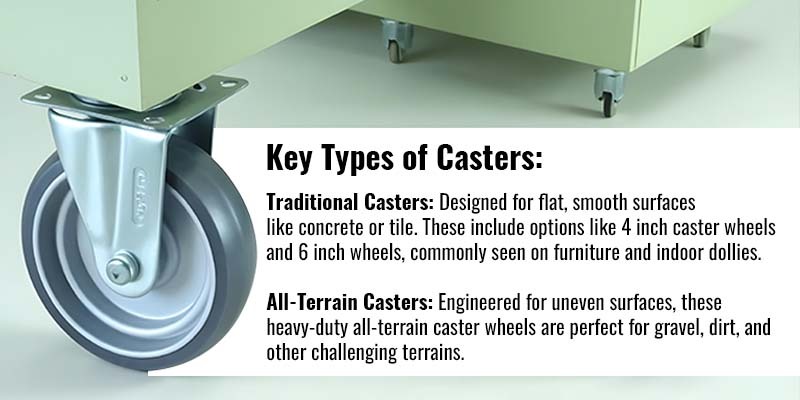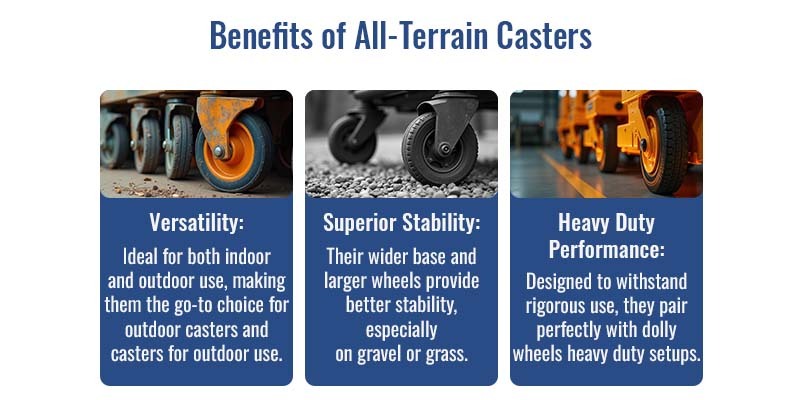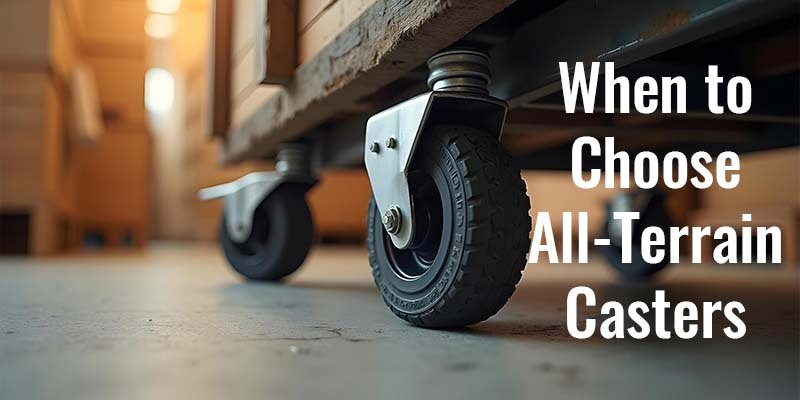All-Terrain Caster Wheels vs. Traditional Wheels: Which One Do You Need?
Apr 25th 2025
When moving heavy loads or maneuvering equipment, choosing between an all-terrain caster and traditional wheels can make or break your experience. As someone who has spent plenty of time selecting and using various types of casters for outdoor and indoor projects, I know firsthand how crucial it is to pick the right one for the job. Let’s dive into what sets these wheels apart, their specific use cases, and how to choose the perfect caster for your needs.
What Are Caster Wheels?
Caster wheels are small wheels mounted on a rotating housing, allowing for smooth movement of equipment and furniture. Casters are essential for mobility, whether you’re outfitting a cart, dolly, or industrial machine. However, not all casters are created equal.
Key Types of Casters:

- Traditional Casters: These are designed for flat, smooth surfaces like concrete or tile. Options include a 4-inch caster and 6-inch wheels, commonly seen on furniture and indoor dollies.
- All-Terrain Casters: Engineered for uneven surfaces, these heavy-duty all-terrain caster wheels are perfect for gravel, dirt, and other challenging terrains.
Understanding All-Terrain Caster Wheels
All-terrain caster wheels are designed to handle rough and uneven surfaces with ease. Choosing the right type ensures durability, stability, and smooth movement across various environments.
Features of All-Terrain Casters
All-terrain casters are designed with durability and versatility in mind. Here are some standout features:
- Larger Wheel Diameter: Typically starting at 12 wheels or more extensive, these casters can handle uneven surfaces better than smaller wheels.
- Durable Materials: Heavy-duty rubber, polyurethane, or pneumatic tires make them resilient against wear and tear.
- Higher Weight Capacity: Some models, like 1000 lb caster wheels, can handle significant loads.
Benefits of All-Terrain Casters

- Versatility: Ideal for indoor and outdoor use, making them the go-to choice for outdoor casters and outdoor use.
- Superior Stability: Their broader base and larger wheels provide better stability, especially on gravel or grass.
- Heavy Duty Performance: Designed to withstand rigorous use, they pair perfectly with heavy-duty dolly wheel setups.
Best Uses for All-Terrain Casters
- Moving equipment on construction sites
- Transporting goods across outdoor event venues
- Maneuvering carts through parks, gardens, or farms
Examples of All-Terrain Casters
- Pneumatic All-Terrain Casters
- Features: Equipped with air-filled tires, these casters provide excellent shock absorption and maneuverability on uneven surfaces.
- Ideal For: Construction sites, outdoor event setups, or garden equipment.
- Example Use Case: Transporting a generator across gravel using a dolly with heavy-duty wheels.
- Polyurethane All-Terrain Casters
- Features: Made with rugged polyurethane treads, these wheels resist punctures and wear. They handle heavy loads like 1000 lb caster wheels and perform well in rough outdoor conditions.
- Ideal For: Warehouse carts used in mixed indoor-outdoor environments.
- Example Use Case: Moving heavy crates from a warehouse to a loading dock over a mix of concrete and dirt.
- Large Dual-Wheel All-Terrain Casters
- Features: Dual-wheel designs provide extra stability and weight distribution, making them great for transporting bulky items.
- Ideal For: Agricultural equipment and industrial carts.
- Example Use Case: Maneuvering a water tank on uneven farm terrain.
- Locking Swivel All-Terrain Casters
- Features: Combine rugged all-terrain capabilities with a locking mechanism for stability during stationary use.
- Ideal For: Mobile workstations or portable toolboxes used outdoors.
- Example Use Case: A mobile tool cart used on a construction site.
Traditional Caster Wheels: The Basics
While all-terrain casters excel in rugged environments, traditional caster wheels dominate in controlled settings like warehouses or offices.
Features of Traditional Casters
- Compact Sizes: Ranging from 1/2 caster wheels to 4-inch wheel options.
- Wide Range of Styles: Options like 4-inch swivel caster wheels or casters with brakes for precise control.
- Light to Medium Weight Capacity: Designed to support moderate loads while maintaining smooth operation.
Benefits of Traditional Casters
- Affordable: Generally more cost-effective than heavy-duty alternatives.
- Quiet Operation: Smooth rolling on even surfaces without excessive noise.
- Easy to Install: Accessories like a caster wheel socket simplify swapping wheels.
Best Uses for Traditional Casters
- Office chairs, furniture, and workstations
- Warehouse carts and shelving units
- Indoor dollies and small-scale equipment
All-Terrain Casters vs. Traditional Wheels: A Side-by-Side Comparison
Understanding the differences between all-terrain casters and traditional wheels helps you select the best option. This comparison highlights key features, performance, and ideal usage scenarios.
|
Feature |
All-Terrain Casters |
Traditional Casters |
|
Weight Capacity |
Up to 1000 lb caster wheels |
Light to medium loads |
|
Surface Compatibility |
Gravel, dirt, grass, concrete |
Smooth, even surfaces only |
|
Size Range |
Larger sizes (e.g., 12 wheels) |
Smaller sizes (e.g., 4 inch wheel) |
|
Durability |
Designed for heavy-duty, outdoor use |
Limited to indoor use |
|
Price |
Higher investment for durability |
Budget-friendly options available |
Features to Look for When Choosing Casters
Whether you’re selecting outdoor casters and wheels or looking to upgrade a dolly with dual wheel casters, here are some factors to consider:
1. Weight Capacity
Selecting the right caster begins with understanding weight capacity. Heavy-duty projects require robust options like dolly wheels and heavy-duty or heavy-duty rollers, which can support up to 1,000 pounds or more. Exceeding a caster’s limit can lead to failure, uneven movement, or floor damage. Always check manufacturer specifications to ensure safe and efficient operation. For industrial applications, consider reinforced steel casters or polyurethane wheels designed for high-load environments.
2. Size
Wheel size affects mobility, stability, and performance. Larger wheels, such as 6-inch options, provide smoother rolling and better shock absorption on uneven surfaces. They also require less force to move heavy loads. Smaller wheels, like 1/2-inch caster wheels, are ideal for compact equipment and confined spaces, offering precise maneuverability. When choosing a wheel size, consider the operating environment and the type of flooring to ensure optimal performance.
3. Mobility Features
Casters with improved mobility features uplift safety and control. Locking swivel casters allows for easy direction changes while providing stability when needed. Casters with brakes prevent unwanted movement on inclines or during stationary use. Some models feature total-lock brakes, securing both the wheel and the swivel mechanism. These options are essential for workstations, carts, and equipment that require both flexibility and stability in operation.
4. Surface Compatibility
Choosing the correct caster material ensures smooth and efficient movement. All-terrain caster wheels work best on rough surfaces like gravel, dirt, and grass, providing durability and shock absorption. For polished floors or tile, 4-inch swivel caster wheels with non-marking rubber or polyurethane treads prevent scuffs and ensure quiet operation. Selecting the right wheel type based on surface conditions uplifts mobility, protects flooring, and extends the caster lifespan.
5. Caster Plate Size
The caster plate size determines compatibility with mounting surfaces. When upgrading or replacing casters, measure the existing plate dimensions and hole spacing to ensure a proper fit. If changing from a small to a larger plate, verify that the new plate aligns with the mounting area. Using an incompatible plate size can lead to instability or installation issues. Always choose a plate that provides a secure attachment and distributes weight evenly.
When to Choose All-Terrain Casters

You’ll want to prioritize all-terrain casters when:
- Working outdoors or in rugged environments
- Moving heavy loads (up to 1000 lbs or more)
- Navigating uneven surfaces that traditional casters can’t handle
Examples of Traditional Casters
- 4 Inch Swivel Caster Wheels
- Features: Compact and highly maneuverable, these casters are perfect for smooth indoor surfaces.
- Ideal For: Office chairs, workstations, or carts.
- Example Use Case: Adding mobility to a home office desk chair.
- Rubber Casters with Brake
- Features: Soft rubber treads provide quiet operation and added grip, with a built-in brake for stationary stability.
- Ideal For: Medical carts, retail displays, or shelving units.
- Example Use Case: A shelving unit in a retail store that occasionally needs to stay in one place.
- 1/2 Inch Casters for Lightweight Use
- Features: Small and lightweight, these casters are designed for light-duty applications like small furniture or decorative stands.
- Ideal For: Small home projects or hobbyist use.
- Example Use Case: A small DIY rolling planter box for indoor use.
- 6 Inch Wheels for Industrial Applications
- Features: Slightly larger wheels with a higher weight capacity, these casters are great for moderate industrial loads.
- Ideal For: Warehouse carts or trolleys.
- Example Use Case: Moving stocked carts in a distribution center over polished concrete floors.
When to Choose Traditional Wheels

- Office setups or furniture adjustments
- Indoor warehouses with flat surfaces
- Lightweight to moderate load requirements
Standard Accessories to Pair with Your Casters
To improve functionality and ease of installation, consider the following:
- Caster with Brake: Ideal for keeping your equipment stationary when needed.
- Caster Wheel Socket: Ensures a secure fit when installing new wheels.
- Dolly Casters: For mobility solutions in both indoor and outdoor settings.
Practical Tips for Maintaining Casters
- Regular Cleaning: Remove debris, especially for outdoor casters exposed to dirt and gravel.
- Lubricate Moving Parts: Ensure smooth rotation and prevent squeaking.
- Inspect for Wear and Tear: Replace worn-out wheels or parts like the caster plate to avoid mishaps.
Final Thoughts
Choosing between all-terrain caster wheels and traditional casters depends on your specific needs. For rugged outdoor environments, nothing beats heavy-duty all-terrain caster wheels paired with a solid setup like dolly wheels heavy duty. On the other hand, for smooth indoor operations, traditional casters like 4-inch caster wheels are reliable and cost-effective.
Whether you need casters for outdoor use, locking swivel casters, or a complete caster upgrade, understanding your requirements will help you make the right choice. Feel free to share your experience with caster wheels or ask me questions—I’d love to help you find the perfect fit!
Need help selecting the right caster wheel for your next project? Reach out for expert advice and recommendations at Atlanta Caster!




 Email US
Email US
 Hours
Hours
 Visit Our Showroom
Visit Our Showroom




